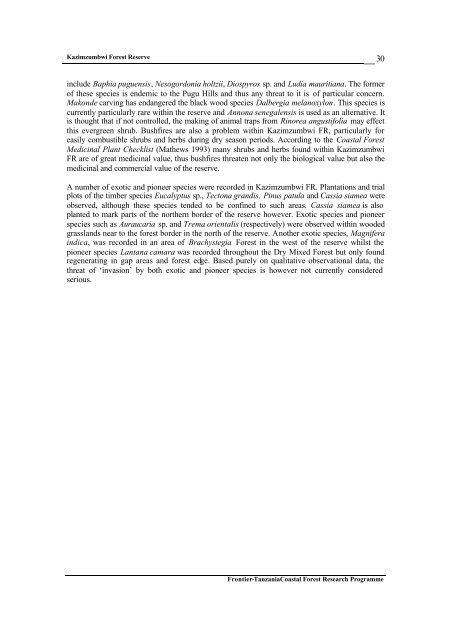Frontier Tanzania Environmental Research REPORT 110 ...
Frontier Tanzania Environmental Research REPORT 110 ...
Frontier Tanzania Environmental Research REPORT 110 ...
Create successful ePaper yourself
Turn your PDF publications into a flip-book with our unique Google optimized e-Paper software.
Kazimzumbwi Forest Reserve<br />
30<br />
include Baphia puguensis, Nesogordonia holtzii, Diospyros sp. and Ludia mauritiana. The former<br />
of these species is endemic to the Pugu Hills and thus any threat to it is of particular concern.<br />
Makonde carving has endangered the black wood species Dalbergia melanoxylon. This species is<br />
currently particularly rare within the reserve and Annona senegalensis is used as an alternative. It<br />
is thought that if not controlled, the making of animal traps from Rinorea angustifolia may effect<br />
this evergreen shrub. Bushfires are also a problem within Kazimzumbwi FR, particularly for<br />
easily combustible shrubs and herbs during dry season periods. According to the Coastal Forest<br />
Medicinal Plant Checklist (Mathews 1993) many shrubs and herbs found within Kazimzumbwi<br />
FR are of great medicinal value, thus bushfires threaten not only the biological value but also the<br />
medicinal and commercial value of the reserve.<br />
A number of exotic and pioneer species were recorded in Kazimzumbwi FR. Plantations and trial<br />
plots of the timber species Eucalyptus sp., Tectona grandis, Pinus patula and Cassia siamea were<br />
observed, although these species tended to be confined to such areas. Cassia siamea is also<br />
planted to mark parts of the northern border of the reserve however. Exotic species and pioneer<br />
species such as Auraucaria sp. and Trema orientalis (respectively) were observed within wooded<br />
grasslands near to the forest border in the north of the reserve. Another exotic species, Magnifera<br />
indica, was recorded in an area of Brachystegia Forest in the west of the reserve whilst the<br />
pioneer species Lantana camara was recorded throughout the Dry Mixed Forest but only found<br />
regenerating in gap areas and forest edge. Based purely on qualitative observational data, the<br />
threat of ‘invasion’ by both exotic and pioneer species is however not currently considered<br />
serious.<br />
<strong>Frontier</strong>-<strong>Tanzania</strong>Coastal Forest <strong>Research</strong> Programme

















